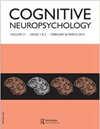Identifying the neural loci mediating conscious object orientation perception using fMRI MVPA.
IF 1.7
3区 心理学
Q2 PSYCHOLOGY
引用次数: 2
Abstract
Vannuscorps et al. (2021) present a comprehensive set of carefully designed behavioural experiments to characterize a young woman’s (“Davida’s”) unique neuropsychological deficit in object orientation perception. Specifically, when presented with 2D shapes defined by sharp edges with medium to high contrast, Davida reports seeing 90° and 180° rotated, and mirror-reversed, versions of the same shapes. By contrast, when shown 3D shapes or 2D shapes defined by blurred edges with low contrast, Davida’s performance is intact compared to agematched control participants. Vannuscorps et al. theorize that Davida’s deficit arises from a failure to map intermediate shape-centered representations (ISCRs) derived from cues preferentially processed in the parvocellular visual pathway from retinotopic coordinates to the higher-level spatiotopic or bodycentered coordinates that undergird conscious perception and action. They further propose that midlevel ventral stream regions such as LO1/2 (V4d in monkeys) may encode these ISCRs in retinotopic coordinates before they are transformed into spatiotopic or body-centered coordinates in downstream ventral and dorsal stream regions. Representations of multiple spatial reference frames have been most prominently associated with the primate posterior parietal cortex (PPC). In neuropsychological studies, damage to the human PPC has been linked to spatial neglect, which can occur with respect to retinotopic, body-centered, or spatiotopic reference frames (Halligan et al., 2003). In macaques, representations of different spatial reference frames have been linked to neurones in different subregions within the intraparietal sulcus (Colby & Goldberg, 1999). The re-representation of visual information from retinotopic coordinates in early visual areas to other reference frames is consistent with the idea that PPC plays an important role in the adaptive and dynamic aspect of visual information processing, whereby input from the ventral visual cortex is transformed to facilitate task performance and efficient interaction with the external world (Xu, 2018a & 2018b; see also Vaziri-Pashkam & Xu, 2017). Whereas previous studies have linked the representation of multiple spatial reference frames to PPC, Vannuscorps et al. (2021) suggest that it could occur earlier in regions immediately downstream from LO in the human brain, such as in V3A/V3B and IPS0. These brain regions have previously been linked to the representation of 3D space (e.g., Georgieva et al., 2009), the tracking of up to four object locations, and visual grouping (Bettencourt & Xu, 2016a; Xu & Chun, 2006, 2007 & 2009). The possibility of linking Davida’s behavioural deficit and the transformation of spatial reference frames to this general brain region presents an exciting opportunity that could help us better understand the precise function this region may play in visual perception. Vannuscorps et al. presume that Davida’s processing of the orientations of 2D shapes with sharp edges is intact early in cortical processing, and that her orientation perception deficit occurs when the retinotopic coordinates of these shapes are remapped onto higher-level spatiotopic or body-centered coordinates. However, this assumption has not been directly tested and it remains possible that orientation processing deficits could have occurred much earlier for these shapes during cortical processing.利用fMRI MVPA识别介导有意识物体定向感知的神经位点。
本文章由计算机程序翻译,如有差异,请以英文原文为准。
求助全文
约1分钟内获得全文
求助全文
来源期刊

Cognitive Neuropsychology
医学-心理学
CiteScore
5.50
自引率
11.80%
发文量
23
审稿时长
>12 weeks
期刊介绍:
Cognitive Neuropsychology is of interest to cognitive scientists and neuroscientists, neuropsychologists, neurologists, psycholinguists, speech pathologists, physiotherapists, and psychiatrists.
 求助内容:
求助内容: 应助结果提醒方式:
应助结果提醒方式:


